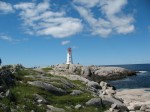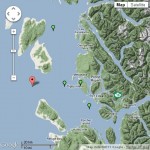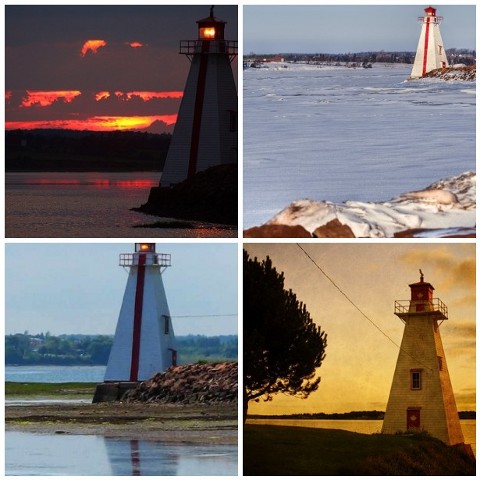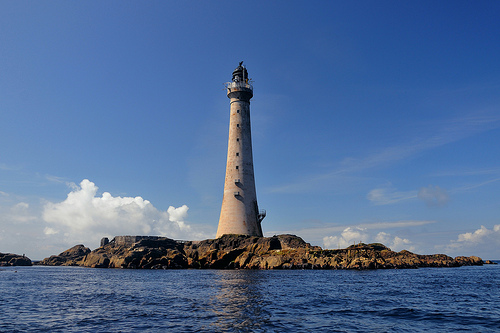For years past, adults and children of all ages had dreams of growing up to be an adventurous lighthouse keeper. That dream is slowly dimming as the world automates its lighthouses.
The following article from The Guardian brings to our attention the dimming of the dream in the UK
The lure of the lighthouse for our islanded souls
With the last lights set to go out, many of us will miss these concrete symbols of our humanity
by Joe Moran The Guardian, Saturday 12 April 2014.

Growing up, I wanted to be a lighthouse keeper. Just like Moominpappa in Tove Jansson’s Moomin books, my ambition was to live on the loneliest lighthouse on the remotest skerry farthest from land. It didn’t end well for Moominpappa, the island he and the other Moomins settled on being barren and desolate, inhabited only by a silent fisherman who turned out to be the ex-lighthouse keeper driven mad by loneliness. It didn’t put me off.
I have since met many compatriots who have had the same dream, for there is something about lighthouses that seems to speak to our islanded souls. more . . .
[private]
Now, to celebrate the quincentenary of Trinity House, the organisation responsible for the lighthouses of England and Wales, an exhibition is opening at the National Maritime Museum. Guiding Lights will display intricate models of lighthouses and lighthouse keepers’ personal effects. It is hard to imagine a similarly pulse-quickening exhibition about air-traffic controllers or road-safety officers, although our lives are similarly in their hands.
“I meant nothing by the lighthouse,” Virginia Woolf wrote of its role in her most celebrated novel, “but I trusted that people would make it the deposit for their own emotions.” Lighthouses, Woolf realised, are endlessly suggestive signifiers of both human isolation and our ultimate connectedness to each other. Artists, from John Constable to Eric Ravilious, have made them the focus of their paintings, which can’t simply be to do with their pleasingly vertical contrast with the horizon.
I suspect that lighthouses appeal especially to introverts like me, who need to make strategic withdrawals from the social world but also want to retain some basic link with humanity. A beam sweeping the horizon for the benefit of ships passing in the night is just that kind of minimal human connection. “Nothing must be allowed to silence our voices … We must call out to one another,” wrote Janet Frame, a shy New Zealand writer also fascinated by lighthouses, “across seas and deserts flashing words instead of mirrors and lights.”
I finally cured my lighthouse fantasy by reading Tony Parker’s oral history of lighthouse keepers. Looking after a light – no keeper ever called it a lighthouse – was, I learned, a tedious job, with little to do but linger over meals and make ships in bottles. One keeper was so lonely that in the middle of the night he switched on the transmitter and listened to the ships radioing each other, just to hear some other human voices. The tower lights, the ones that rise impossibly out of the sea and carry the most romantic connotations for landlubberly ignoramuses like me, were the most dreaded by the keepers. Without even a bit of rock to walk around on and escape from your housemates, they were the lighthouse-keeping equivalent of being posted to Siberia.
In any case, I was well out of it because lighthouse keeping was not a job with prospects.
The lighthouses began to be automated in the 1970s and the last keeper left the last occupied lighthouse in 1998. Now, in an age of radar and computerised navigation systems, working lighthouses are an endangered species. Their haunting fog signals are being switched off. Their black-and-red painted stripes, meant to stand out against the land and sky, are being left to peel off. And many lighthouses are being decommissioned, turned into holiday cottages or expensively renovated homes.
No doubt satnav will now do the job just as well, but it will be a shame when the last lighthouse turns off its light. In an age when we have to justify public projects with the consumerist language of stakeholders and end users, lighthouses still feel like an uncomplicated social good that belongs to us all. They are the concrete symbol of our common humanity, of the fact that people we may never meet – at whom we may do no more than flash our lights in the dark – are also our concern.
*************************
One of my dad’s oldest friends was a lighthouse keeper for a few years. He was sometimes posted to those lights that stand alone on a rock. In a ‘big sea’ waves could be so high that water would come down the chimney and put the fire out. He also said that if your hearing went dull it meant that the level you were on was underwater because of a big swell – and a thick metal door was the only thing keeping the Atlantic out.
There are terrible stories. One was the lighthouse often had to eat the tallow candles when ships bringing supplies could not make it through the rough sea. Also the tradition of 2 keepers came into being when one single went out of his mind.
I’ve a slight problem with repeated ref to concrete. Most early lights were built with granite(or timber with plinth granite) interlocked water proof hydraulic cement. Smeaton’s Eddystone the prototype, and later Stephenson family business up north.
To be honest lighthouses are no longer necessary as the coastline is now starkly outlined by the amount of light pollution from our towns, cities and villages. You really can’t miss it when sailing down the coast. Also our new technologies are way in advance of anything we’ve had in the past and even a small yacht can now pinpoint its position to a matter of metres on the ocean. So if we do have any shipping catastrophes in the future they are likely to be down to human error.
“even a small yacht can now pinpoint its position to a matter of metres”
I too sail a small yacht in and around NW Scotland and, because I lack all but the most basic GPS, compasses and echo sounder, greatly value our lighthouses – albeit, unmanned. You will know that whenever NATO carry out exercises in the Minch, warships regularly cause GPS screens to go blank!!! Serious accidents are not unknown.
You are referring to an exercise 2 years ago where warships blocked GPS for 20 miles. There were no accidents but due to complaints Warships in UK waters are now banned from blocking GPS. I’m not sure about other navies though.
Not every small boat has radar… not all coastlines are outlined by light pollution.
But most people now have mobile phones/iPads/Tablets with GPS.
Please, please, please do not go to sea relying on an iPad/phone etc for navigation! Road signs, and indeed ‘roads’ themselves are fairly limited at sea in my experience.
I can see one of our oldest lighthouses from here. It is on the top of St Catherine’s Down and known locally as the Pepperpot. It was built by local people as a punishment for buying smuggled wine. There was an oratory attached to it at one time to say prayers for the souls of the shipwrecked of whom there were many and the graves in the churchyard will attest. Although high up it wasn’t much use as the mist which frequently covers that part of the coast line blocked out the light when it was most needed and many ships went aground on the notorious Atherfield ledge. The new lighthouse built by the shore is a beautiful building and it would be a great shame if it were to become just another house, although coastal erosion and land slips might put off anyone but the most foolhardy from purchasing.
Foolish idea turning these off. Given potential failures of equipment these are very useful as a last backup. Oh well I’m sure it saves some middle managers budget some money somewhere.
This is a shame, lighthouses are exciting. I don’t think it’s possible to go on holidays to the coast without spending some time watching out for the distant lights and trying to identify them. I know we used to look forward to foggy days so we could hear their fog horns going off.
And at night, if you were staying in a house nearby, some of the beam would sweep around the bedroom from time to time.
Many years ago I recall reading an article in some sailing magazine. Title was The Antikythera Light. The author told of sailing through a storm in the Eastern Med. He had been at sea for days on end and the storm had bounced his small boat around quite a bit. This was long before GPS and he didn’t know exactly where he was. He knew he was approaching the Greek islands and some very dangerous and rocky shores. Then, flickering on the horizon in the far distance and through the storm…a flashing light. Lights flash in timed sequences and those are indicated on charts. He identified this one as the light on Antikythera, the island in the center of the passage through into the Aegean Sea.
Now he knew where he was. Now he was safe. He wrote of his grateful appreciation, not only for the light keeper whose job it was to help people the keeper would never see, but to the society that posted the man there and built the tower and light that led him to safety out of a storm, money spent for no special benefit to the community but only to the benefit of passing strangers in need of help.It was a wonderful essay on how humanity consists of people doing altruistic things, not only for strangers, but for strangers they would never know needed the help. Lighthouses are a symbol of what is best in all of us.
A good few years ago we did the soundtrack to this short documentary about the some of the last people to man the lighthouses, they tell their stories and explain how automation affected them, very sad some of it: http://vimeo.com/m/71760571
Bishop Rock lighthouse – the westernmost point of the Isles of Scilly – that’s the one I’d most like to go inside. And I’d pay good money to see the BBC documentary about it, by Tony Parker, first shown just over 40 years ago: http://trinityhousehistory.wordpress.com/2014/02/06/on-this-day-in-trinity-house-history-6-february/
[/private]


















